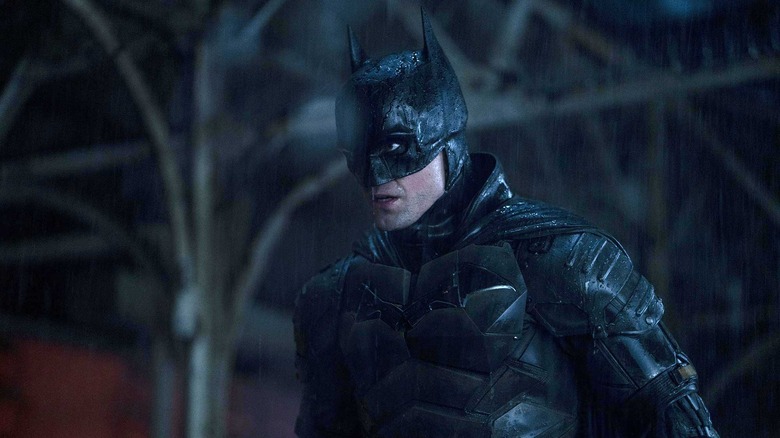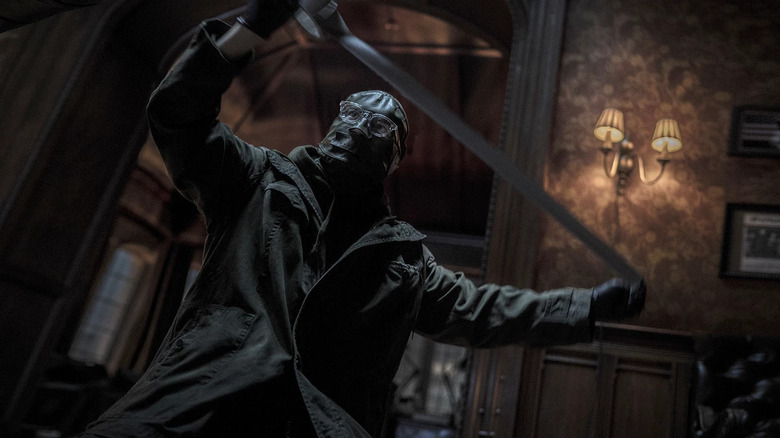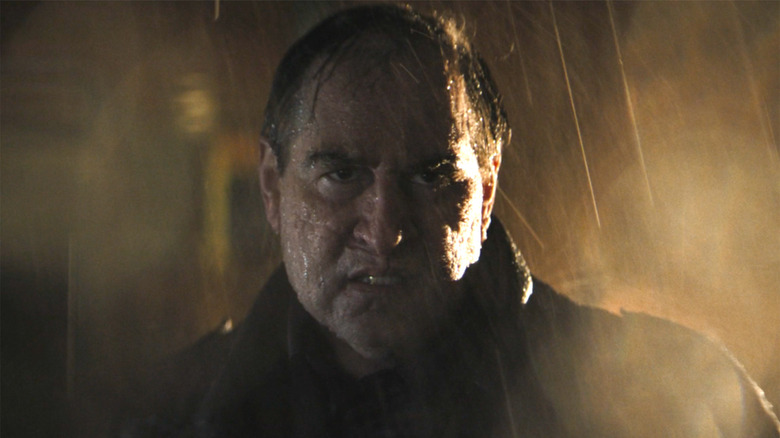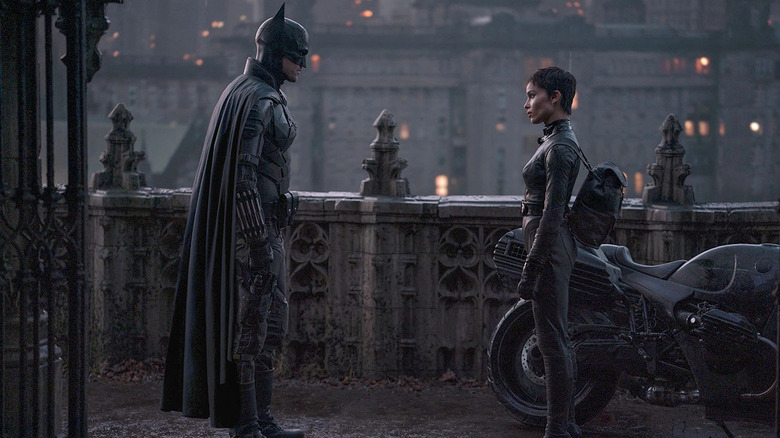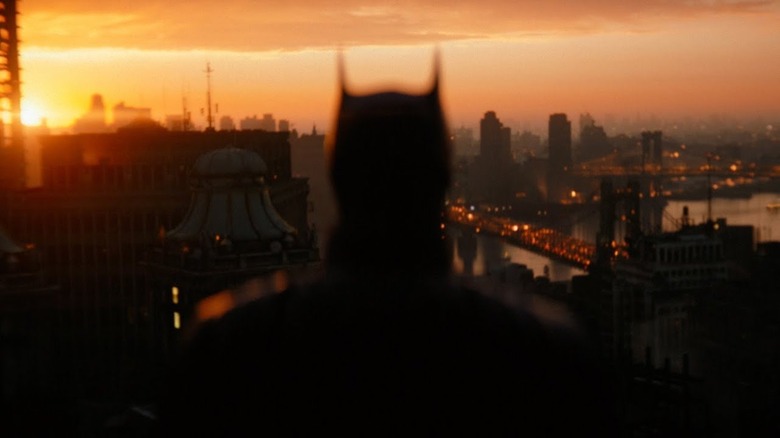The Batman Spoiler Review: An Emo Caped Crusader For An Emo World
How do you make a new Batman movie fresh? It's been just under ten years since the last solo live-action Batman movie, qualifiers which you need to include unless you want to reference the Ben Affleck era of Batman or the exuberantly funny animated film "The Lego Batman Movie." When Christian Bale hung up the cowl with the 2012 film "The Dark Knight Rises," it felt like the end of an era. With hindsight, the Bale/Nolan era's conclusion was more of a blip. Whereas the world of the Marvel Cinematic Universe is so rigorously mapped out that it's next to impossible to imagine a scenario where someone else would play Tony Stark or Thor or any number of other heroes (at least not for a long time), DC is about constant renewal.
If you saw "The Batman" over the weekend in your local multiplex, you know that "renewal" is a very apt word to utilize in relation to this massive, epic-length, and surprisingly satisfying (if, yes, overlong) depiction of a city on the constant edge of disaster. Even more than recent iterations, "The Batman" is successful at harnessing real-world struggles and stresses into the world of a grim, brooding superhero whose exploits this time around are cut from a cloth inspired by old-school film noir.
As you may already know, "The Batman" — co-written and directed by Matt Reeves of the beloved romantic comedy "The Pallbearer" ... and yes, fine, the "Planet of the Apes" trilogy — stars Robert Pattinson as billionaire Bruce Wayne and his caped counterpart The Batman. As Bruce intones in voiceover, the events of the film take place over the span of one week, from Halloween to the day after Election Day in Gotham City. As Bruce alludes in these voiceovers, taken from a meticulous journal he keeps on the whole "Dress up like a bat and fight crime" thing, he's been the Batman for a full year and entering his second when we meet him in the shadows of a Gotham subway station. This is where he reveals his true nature when asked by a group of white-painted thugs beating up a defenseless citizen: "I'm vengeance".
Riddle me this
Now, granted, we don't meet Bruce Wayne or The Batman first. After stark studio logos and the film's title (all in red), we get to see through the binoculars of the cling-wrap-laden villain known as the Riddler (Paul Dano). He's spying on a man (Rupert Penry-Jones), his wife and his son from across their swanky apartment, breathing heavily before he enters from the rooftop. As he does, we realize the man is current Gotham City Mayor Don Mitchell, grimly watching a recent debate he had with mayoral candidate Bella Reál (Jayme Lawson). But soon enough, he's attacked from behind by the Riddler, who then brutally murders him, all to the tune of recurring musical motif "Ave Maria."
That murder is just the first of a handful in the aforementioned week that grips Gotham in a state of existential terror from the mysterious figure with a hidden face, warped voice, and glee at filming himself killing people in disturbing fashion. It's here that I should note the number of seemingly intentional cinematic references in how Reeves has re-conceived the Riddler, from Jigsaw in the "Saw" franchise to the harrowing John Doe in David Fincher's "Se7en" to the Joker himself, at least as portrayed by the late Heath Ledger. You don't likely need to be given this warning, but if you're expecting something in the vein of Frank Gorshin from the "Batman" TV show or Jim Carrey in "Batman Forever", well ... lower those expectations.
While the Riddler seems like a Zodiac-esque serial killer being hunted down haplessly by the Batman and his police contact, Lieutenant Jim Gordon (Jeffrey Wright), he's really trying to balance the scales in favor of the have-nots by taking out the haves in Gotham City, revealing that the fabled Gotham Renewal Project, touted in the film as early as the opening sequence by the soon-to-be-dead Mayor Mitchell, is a lie. What the late Thomas Wayne spearheaded years ago while running for mayor before his death has turned into a massive slush fund utilized by cops, politicians, and lawyers alike, and all facilitated in the shadows by feared mobster Carmine Falcone (John Turturro).
An unrecognizable red herring?
"The Batman" mostly maintains a very delicate balance throughout its gargantuan running time. The film is heavily steeped in noir, in '90s-era grunge, and even in a dash or two of emo stylings (when we see Bruce Wayne outside of the Bat cowl, his eyes are heavily tinged with black makeup). And yet the film can't be too dour or grimdark, because ... well, again, this is a three-hour movie, and at a certain point, it would just feel a bit punishing. Part of how Reeves and co-writer Peter Craig achieve this balance, at least within the first two hours, is by creating such outsized figures surrounding Bruce/the Batman that they leaven the darkness.
The obvious example is both the most intriguing and the most disappointing: Oswald "Oz" Cobblepot, nicknamed the Penguin for his facial scarring and strange limp. Even more than the presence of Dano as the Riddler, the appearance of Colin Farrell as the Penguin has been a selling point in the ad campaign, going back as far as the DC FanDome teaser that leaned on a car chase sequence that is easily the action high-point of "The Batman." In that scene and elsewhere, Farrell is having the time of his life even while caked in some of the most genuinely impressive makeup and prosthetics this side of Eddie Murphy in "The Nutty Professor" films. (On one hand, it's dumb to begin next year's Oscar discourse now. On the other hand, if this film does not win for Best Makeup, it will be ridiculous.) Farrell's tough-guy American voice isn't unrecognizable if you know his broader filmography, but he's otherwise nowhere near the dashing figure seen in countless other films.
And Farrell is having so much fun ... that it is genuinely a letdown to see the Penguin serve as little more here than a red herring. As the deaths of major Gotham City figures mount, including the grouchy police commissioner (who's also Gordon's ex-partner) and the city's district attorney (Peter Sarsgaard, in a very effective and weaselly extended cameo), the Batman and Gordon, with the help of Bruce's butler and surrogate father Alfred (Andy Serkis), begin deciphering the Riddler's symbolic clues. One of those clues features a Spanish phrase — "el rata alada" — that may point to the identity of a mysterious informant the Riddler is trying to unmask, having helped bring down infamous mobster Salvatore Maroni as part of the city's biggest-ever drug bust. The Batman and Gordon believe "el rata alada" means "the rat with wings", and who better than the Penguin to fit that description? After Sarsgaard's sweaty D.A. refuses to name the informant (and is blown up in the process at the mayor's funeral), the Batman chases after the Penguin, leading to that incredible action scene, which also unveils the Pattinson-era version of the Batmobile. The scene, immaculately shot by director of photography Greig Fraser, is bleakly distinctive, with explosions and fire illuminating the inky-black Batsuit and Batmobile in the dark of night. It's a grimly gorgeous scene, climaxing in the upside-down POV shot of the Batman slowly walking to the Penguin, stuck in his destroyed car.
... And then Batman and Gordon quickly learn they're wrong about the Penguin. Is he, generally speaking, a criminal? Sure. Super-scummy? You bet. The informant? Not at all. Plus, he helps clarify their mistranslation of Spanish. It turns out that the stool pigeon isn't the Penguin, and "el rata alada" is meant to refer to ... well, what would you think of when you hear of a "rat with wings"? Perhaps, say ... a bat? It's intended as the Riddler's warning for who he wants to truly target next: the Batman. The informant is soon revealed to be none other than Falcone himself, who used the opportunity to shore up power after the death of Thomas Wayne, a death he initially fingers on the oft-discussed but never-seen Maroni, but one that he likely staged himself. When the infuriated Batman brings Falcone out of his Iceberg Lounge to be arrested, the Penguin expresses his fury that his boss was ever a rat, and the implication is clear: with the power vacuum in place with Falcone's absence, who will take over but him? That's got to be the safe assumption, but what it means is that as enjoyable as Farrell is here, the Penguin ... is kind of useless within the broader context of a very long film. Yes, fine, he's here to be set up as a big bad guy for the sequel, but considering how flamboyantly oily he is here, Farrell ... well, one imagines he got a good paycheck. At least he earned it.
The Bat and the Cat
Far more important is the other key figure in "The Batman": Selina Kyle (Zoe Kravitz), better known in the lore of Batman as Catwoman. This Catwoman, much like every other character in the new film, is less an actual superhero than someone who's justifiably angry at the world and trying to scrape out an existence amidst Gotham's vast sea of corruption. Selina's talents as a cat burglar become clear after Bruce catches her breaking into the office of the now-dead mayor to try and steal the passport of her friend (or possibly lover — per Kravitz, she read Selina's relationship with her dead roommate Annika as more romantic than not, a choice that is frustratingly subtextual as opposed to being a genuinely progressive creative move), who had been seen with the mayor in photos that eventually are made public.
But Bruce/the Batman soon realizes that Selina is more than just a woman with killer fighting moves who can also rock a black mask. She's also more than just a waitress at the aforementioned Iceberg Lounge. Her first onscreen encounter with Falcone (during which Bruce has her wearing slick contact lens that function as a video camera, attempting to do recon on some of the more guilty corrupt figures in the city) could read as awkward and a bit stilted, but there turns out to be a reason: Falcone is Selina's father, and a pretty crappy one at that. That knowledge fuels Selina's choices of trying to get her own vengeance, just as Bruce's choices get more charged when he learns how his father's death plays into the vast corruption on display in Gotham. Kravitz, as much as Pattinson, is extremely convincing in the role and threads the needle carefully in making Selina both single-minded and fully relatable in her journey.
"The Batman" mostly handles the sins-of-the-father ideas very well throughout the majority of its running time, as well as the notion that the Riddler is, at heart, a wounded orphan inflicting pain on those who left him and his fellow orphans to rot when they were children. If there's anything that reads as a bit odd within the way the Riddler is handled, far more so than any other character here, it's that Reeves waits a very, very, very long time to reveal the man under the mask. The connection to "Se7en" comes in key here — in that film, it takes a long time to reveal the identity of John Doe (Kevin Spacey), and for anyone familiar with the then-character actor's work, his presence as a demented serial killer came as a shock. But if you know Paul Dano is the Riddler, there's ... honestly not much to be surprised by in his eventual reveal. This Riddler isn't hiding his face for a specific reason, and it's not as if Dano looks any different than you'd expect him to once he's unmasked. When the Batman meets him in Arkham Asylum after the madman is caught having wielded the gun that killed Carmine Falcone (right after the mobster was outed as the big stool pigeon), he still looks exactly like Paul Dano, sounds like him, acts like his creepy self, etc. You get the picture.
The hero we deserve
Though the initial interrogation scene, which plays like a new variation on the "We're not so different, you and I" hero/villain dichotomy of countless superhero films, is very effective, thanks to the intensity of Robert Pattison and the squirrelishness of Dano, it's the film's last true pinnacle. From here, there is an extended finale in which the Riddler reveals his final plan: he's going to drown the entire city of Gotham by setting off explosives placed at key parts of the city's edges, cutting its denizens off from help and being forced to die without the Batman to save them. The flooding occurs at the Election Night party of Mayor-elect Reál, at the Gotham City equivalent of Madison Square Garden, with the remaining citizens forced to huddle and evade the gunfire of a group of minions of the Riddler's. It's a sight that recalls nothing short of the insurrectionists at the U.S. Capitol last January.
That's a charged image, one heightened by the reveal that some of these Gotham lunatics watched the Riddler's live-stream videos over the last few days and were encouraged to play copycat: they dress like him, they seem willing to die for his ethos, and they're happy to kill whoever comes in their way. The problem is simple: this movie takes place over the span of six days, and the Riddler does not appear to have killed anyone before the film's opening sequence. Granted, it's not as if he's spawned thousands of imitators, but there's very little attention given to the Riddler's mania infecting people before the finale. And it also robs the action of true punch: with the true villain stuck in Arkham, the finale is just Pattinson in the Batsuit punching random faceless dudes, eventually with Catwoman's help. After they inevitably save the day, Selina goes her separate way from Bruce (an idea literalized as they ride their motorcycles in separate directions in the last moments), but there's always next time, right?
This much is true: "The Batman" is trying very hard to be both a Caped Crusader movie, with all the trappings you expect, from a thunderous car to a rich hero fighting crime by night to a tut-tutting British butler of sorts. (And, as in "Batman Begins", this movie ends with a tease towards a new Joker, this time represented by a fellow Arkham inmate briefly portrayed by Barry Keoghan, in what is the only bad scene of this entire affair.) But "The Batman" is also trying very hard to be a very different kind of movie altogether. This film is no less dark than the Christopher Nolan trilogy or the iteration of the Bat played by Ben Affleck. But it never drowns in that darkness, nor does it feel unearned. It's genuinely remarkable that "The Batman" works as well as it does.
There have been so many versions of this character, so many times that we've all seen how Thomas and Martha Wayne died, so many times that we've seen taciturn men with prominent chins growl their way through dialogue. Yet Robert Pattinson is genuinely effective as a still-fairly-callow version of the Bat, and Matt Reeves brings the same straightforward bleakness that he utilized well in the "Planet of the Apes" redo trilogy of the 2010s, to make "The Batman" a compelling refresher for Bruce Wayne. The film ends with the prospect of Bruce having learned a good deal more about himself, and arguably approaching the next step in his evolution as the Dark Knight (and the next step in his evolution of being an outwardly present billionaire playboy). After so many years, it's surprising to find a sense of intrigue and excitement for another new Batman movie. What a pleasant surprise indeed.
